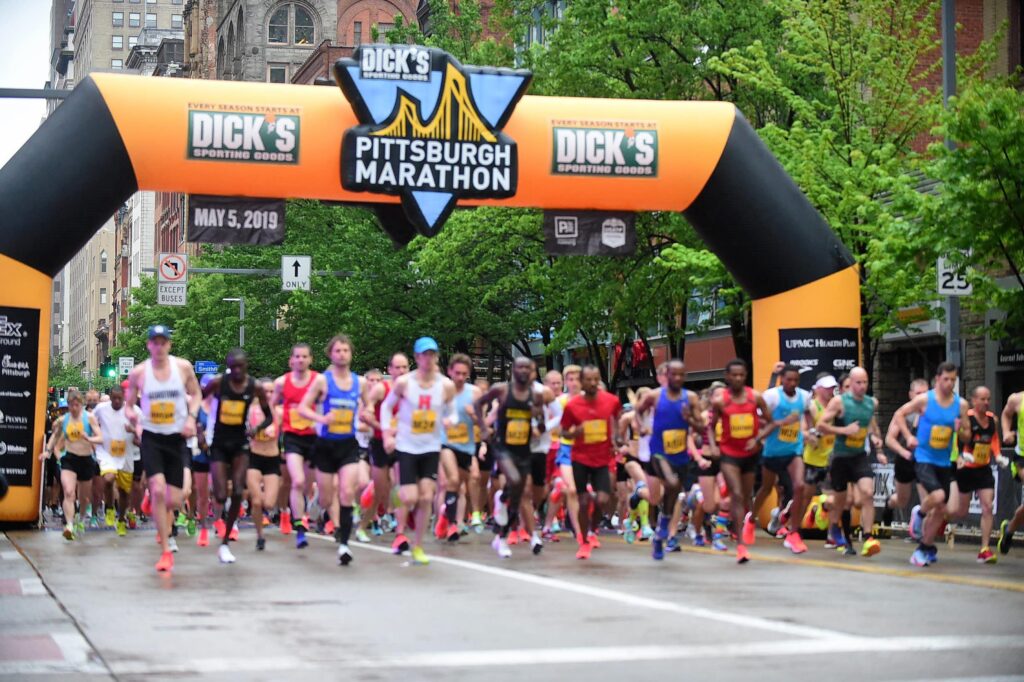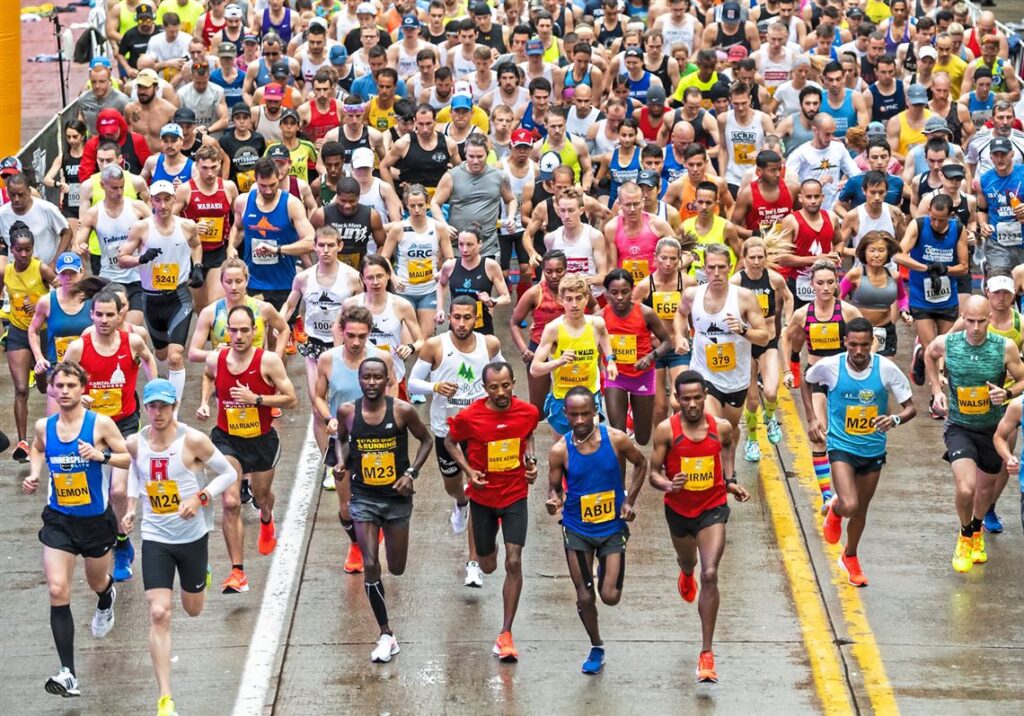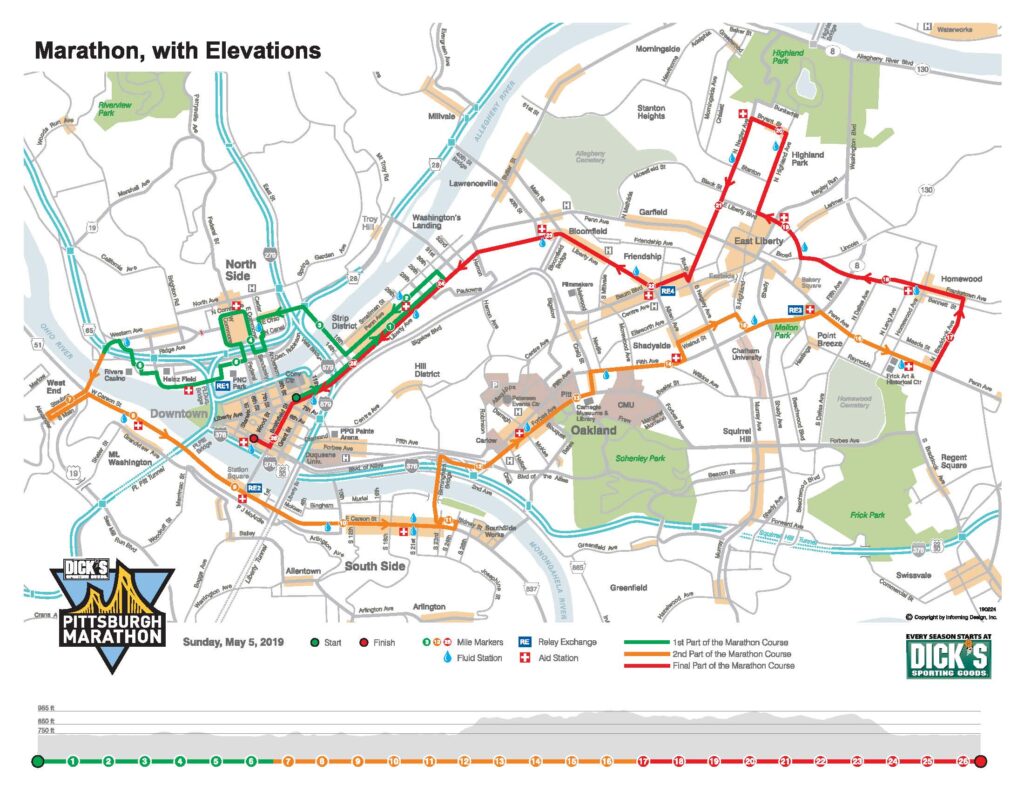
Cold, rainy, hilly, amazing, depleting, exhilarating. These are some simple words to describe my first marathon. When I told my non-running friends that I signed up for the Pittsburgh marathon, most looked at me and subtly shook their heads. Some said I was crazy, others said my knees would wear down from all the running. A few were inquisitive, asking how I was preparing, how far I was running, and why I was running in the winter weather. When I answered them they shook their heads, said I was crazy and my knees would wear down. I told them my knees would be fine.
I prepared like all crazy runners. I ran. A lot. I did speed work, did easy runs, did long runs. I was using an on-line training plan, but was not happy with it and switched to Hansen’s method, which worked well for me. With the marathon in early May, I trained over the winter months. As the weather cooled I learned how to layer clothing and how to select gloves so my hands would neither freeze nor get soaked in sweat. When it snowed I learned how to turn an old pair of shoes into running cleats using sheet-metal screws. I also learned how to get over low motivation on cold, windy days by following Nike’s advice to just do it, and how to run endless miles going nowhere on a treadmill when the weather was too bad to go outside.
While I had run a couple of half-marathons, I had no idea of what to expect in a marathon. So I read books and blogs and magazine articles, I watched running videos, and talked with the few friends of mine who have previously run marathons. Information is calorie free and I ate up as much as I could. Come May, I was book-smart and knew how to pace myself, how to manage fluids and calories, and how to set realistic goals for the marathon. I felt as ready as I was going to be, knowing I still lacked the hard-earned insight into what to expect, especially after mile 20 when experienced runners say the marathon really begins.
The race weekend came and my wife and I drove from the Lehigh Valley to Pittsburgh. We showed up on Saturday, checked into our hotel and went to the expo. It was a beehive of nervous, pent-up energy – trained runners sporting athletic gear and sipping from water bottles as they buzzed from booth to booth. I felt a little out of place with my cargo shorts and Diet Pepsi, but did my best to blend in, grabbed freebees, and bought a Steel City Road Runners hat (my daily wear to this day).
My excitement turned to nervousness when I picked up my bib – #705 – and saw that I was placed in the A coral. There were four corals, “A” through “D”, with A being the fastest runners, and I was certain this was a mistake. I signed up five months ago and thought I must have been a little aggressive when predicting my finishing time. I fell asleep that night with visions of fit and toned runners staring back at me as they flew past at the gun.
I woke up on race morning before my alarm and slipped quietly into the shower so my wife could get a little more sleep. I ate a stale bagel with honey and laid out my gear: Naked running band, bib, assorted Gu gels, Garmin running watch and heart rate monitor chest strap (I’m a data guy), phone, and some “DNF” money in case I fell out of the race and needed to take an Uber back to the hotel. I put on the requisite nipple protection (appropriately named Mr. Nipple – look it up on Amazon) and applied Body Glide to the necessary areas.

We left the hotel, walking out into a cool, drizzly morning, and followed the throngs of runners to the start. I kissed my wife goodby, went through the security checkpoint, and nervously entered the A coral. The start line was to the left, and I turned to the right, Impostor Syndrome leading me to the rear of the coral. My nervousness was captured perfectly by a race photographer in my pre-race “what the hell am I doing here” deer-in-the-headlights photo. Using tiered goals, I hoped to finish around 3:50, with a secondary goal to run under 4:00 and my fallback goal to simply finish. I had thought everyone in the A coral was probably running sub 3:00 and my anxiety eased a little when I saw the 3:40 running group up ahead.

After the National Anthem was sung, the Elite runners started (think of them as the A+ coral), and then a few minutes later the A coral went out. The beginning of the marathon was exactly like my previous half-marathons – running shoulder to shoulder, hoping not to trip over the people around you as you jockey for position, passing slower runners while getting passed by faster runners. By the time these things started to thin out I was already two miles into the race.


The first 12 miles of the Pittsburgh marathon are relatively flat and include three river crossings. The first crossing is over the Allegheny River into the North Side, followed by a crossing over the Ohio River into the West End. Then it’s a few mile run down the South Side along the Monongahela River. I felt pretty good through here. I drank water and the Nuun sports drink provided along the course, and ate a couple of gels. Then came the Birmingham Bridge and with the final crossing over the Monongahela. At this point the half-marathoners turned left for a flat stroll down the Boulevard of the Allies to the finish line. We marathoners (those of us with the yellow bibs) turned right up Forbes Avenue and kissed the flats goodbye.
Forbes Avenue is a big up into Oakland, past University of Pittsburgh and Carnegie Mellon University (I made sure to wear my Lehigh University hat for the race!). The course was then a saw blade of up, down, up, down, over and over. Nothing big, but enough to slowly grind down legs and ankles. As the miles stacked – 17, 18, 19, 20, 21 – the drizzle got heavier and it became drenching and cold. The crowds and volunteers along the course were great, and their energy helped to keep me going through this section.

The real race started for me at mile 23. Here it was mind versus body. There is a big downhill at mile 23 that pounds the legs and then then a two mile straight, flat section leading to downtown and the finish line. I was wet and cold, my energy depleted and thoughts down to nothing more than pain and motion. My hip flexors screamed with each step, refusing to lift my legs more than a few inches, pleading to stop. So innate that my body wanted to curl up at the side of the road and wait for the evening street cleaners to sweep away the pain. This is the part that experienced marathoners try their best to describe, but can’t. You simply need to experience it for yourself and learn that you can push through it. You’ve trained your body and mind over hundreds of miles just to get to here, to now, and only a few more to go.

I knew if I stopped, I would not start running again and I kept telling myself that the pain would be over quicker if I ran to the finish line. So I focused on putting one foot in front of the other, step by step. The flats here were the longest two miles I have ever run. As the finish line got closer, the crowds slowly grew and the noise picked up. Their enthusiasm carried me to the finish line and the most glorious thing I saw was the final set of timing mats marking the end of the race.
I now understand why they hand out silver thermal blankets at the end of a marathon. Here my body shut down and I shivered and shuffled my way through the finish shoot, grabbing some bananas and cookies along the way. The marathon had spotters sitting here in lifeguard towers, looking for finishers in need of medical attention. My only thought as I hobbled past them was to remain semi-upright and not shake too violently. I evaded their attention and eventually found my wife, or I should say she found me. After a slow, cold, painful walk back to the hotel (why were the curbs so high?), I warmed up in the shower, got some calories in me, and thought back on the race.
I had run my first marathon and I met my goal, finishing in 3:46. It was spectacular. It was painful. I learned a lot about myself in the process – not just in the marathon itself, but through the many hundreds of miles of training in all kinds of weather. And the final outcome? I caught the marathon bug. I know I can finish a marathon and now have a new goal. My time for my first marathon was not too far off of the Boston marathon qualifying time for my age group (3:35). So I’m back on the road, putting in more miles – now in the heat of the summer – and looking forward to my next marathon.

